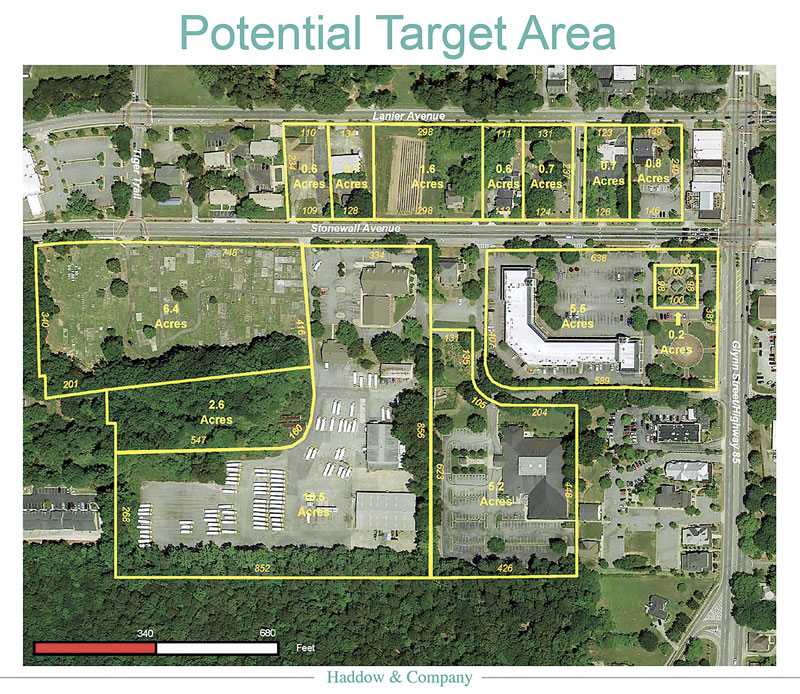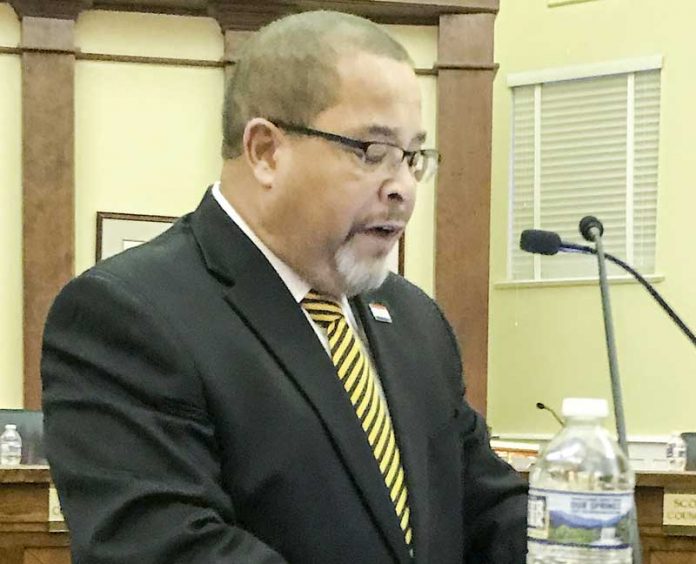The Fayetteville City Council retreat on Feb. 9 included a presentation on the long-discussed downtown master plan. The council established a goal to develop a revised plan by August.
The Fayetteville Downtown Master Plan in the works for more than two years is still on the drawing table. A new proposal by Haddow and Company at the Feb. 9 City Council retreat questioned aspects of the plan proposed six months ago. With Haddow representatives having performed a preliminary analysis to date, company representatives said the September 2016 plan and marketing analysis by Noell Consulting and architect Bill Foley was a good starting point, while questioning some aspects of the large project.
Mayor Ed Johnson after the meeting said the city would “look at all options to bring the master plan into reality.”
The large downtown master plan area includes more than 70 acres forming an arc that begins essentially on the southwest side of Stonewall Avenue and Ga. Highway 85, extends to the west to the 10.5-acre Fayette County Board of Education property, then wraps around to the south and west along Grady Avenue to Ga. Highway 54. The previously-identified plan area also includes property between Stonewall Avenue and Lanier Avenue, from downtown westward to the vicinity of Tiger Trail.
Haddow representatives reviewed previous studies, analyzed demographics and other trends in the city, interviewed Fayette County Administrator Steve Rapson and school Superintendent Jody Barrow, researched property ownership in the downtown area, evaluated significant real estate development either planned or underway downtown and profiled six downtown areas that have recently undergone revitalization efforts.
A key difference in the Haddow proposal would have the area between Lanier Avenue and Stonewall Avenue continuing to east of Tiger Trail be focused more as park space than in the earlier proposal, which had the area between the two streets dotted with retail closest to downtown and multi-family to the west.
Some on the council questioned if park space in that congested area would be the best use of the property.
Haddow representatives said mixed use residential would be expensive to rent, adding that greenspace would be preferable closer to downtown.
The other area to focus on initially would be the current school system property, Haddow said. Beyond that, the master plan should focus on incremental development, representatives said.
Incremental development was also the reality with the former plan since no one envisioned having the entire 70-acre area, which includes many single-family homes along Grady Avenue that would take years to build-out, go under construction simultaneously.
Haddow said Barrow indicated the school system property would be available for sale while Rapson said the same, but with the caveat that the county would need the funds to build a 65,000 sq. ft. building and sufficient parking on a 5-acre site. The price tag, said Haddow, would be in the millions. Essentially, the county has no plans to leave its current location downtown in an office complex originally built for commercial rental space, Haddow said.
That said, Rapson indicated that the county would be potentially open to a building with a joint presence between the city and county provided funding for such a project, such as with bond funding, could be worked out.

Moving forward, Haddow representatives asked the council to consider a series of questions. Those included:
• What does the city want the downtown to become?
• Is a new city hall necessary? If so, how large?
• What is the appropriate scale of public investment?
• What funding sources are available?
• How to phase the revitalization process and where to begin?
Haddow recommended utilizing a phased approach to the downtown plan, one that would work with land planners to explore options, create a preliminary budget, explore financing options, investigate land acquisition targets, meet with major downtown stakeholders and determine the space needs for a new city hall.
One of the goals at the retreat was to develop a revised downtown master plan by August.
With all the talk of a downtown master plan, some residents may not remember that such a plan, at least for the area between Stonewall and Lanier and over to Tiger Trail, is nothing new. It was at the March 2011 retreat that Peachtree City-based Historical Concepts presented a conceptual plan called “Fayetteville Downtown West” to the mayor and council. The original plan came out of a 2010 meeting of the Downtown Development Authority and the Main Street organization.
Termed a long-term development, the proposal was designed to bring historically-oriented, pedestrian-friendly commercial and residential development to the 9.1-acre area immediately west of downtown between Stonewall Avenue and Lanier Avenue and extending to Tiger Trail.
As conceived, the 9.1-acre area positioned between Stonewall Avenue to the south and Lanier Avenue to the north stretches from the commercial area along Glynn Street westward to Tiger Trail and would contain a mixture of commercial and residential space along with 5.4 acres of open space and greenspace.
The older homes would stay in place and compliment the new construction designed to fit seamlessly into the area, the plan noted. As proposed, the development’s five phases would allow for five cut-through streets in addition to Bennett Street, which would be widened, city staff said, adding that new curb cuts would not be needed for the development since a sufficient number of those already exist.
Now years later, and with the advent of Pinewood Atlanta Studios and Pinewood Forrest and other likely projects on the city’s west side, the council, beginning a few years ago, revisited the downtown master plan idea.
Some residents in recent town hall meetings expressed the desire to have enhanced commercial venues, such as upscale restaurants, in Fayetteville. Some in those meetings were unaware that upscale retail businesses will only come to an area with higher density. The way the various plans have been laid out, the downtown area, which would expand and include higher retail density along with the potential of having higher density residential, would help create higher foot traffic in downtown that would help accommodate businesses being drawn to the downtown area.
Two local examples of that reality exist in Newnan and Senoia. Newnan has a much larger downtown area, along with specialty shops, restaurants and offices, that is a continuous draw for large numbers of people.
On a smaller, but equally vibrant scale, Senoia’s downtown continues to expand. Though significantly land-locked, Senoia’s downtown area, and through new and infill quality development, has far eclipsed the offering found in downtown Fayetteville. And though many homes in Senoia are situated only a block away from downtown, those home values have continued to increase to prices never before seen.
The decision by Senoia stakeholders to upgrade and expand the downtown area was made in 2007. Senoia’s downtown at that time had seven businesses open. Within five years, Senoia had 49 businesses open downtown and a waiting list for others wanting to come in. Senoia was on the fast track to becoming a destination even before the TV series “The Walking Dead” came to town.






